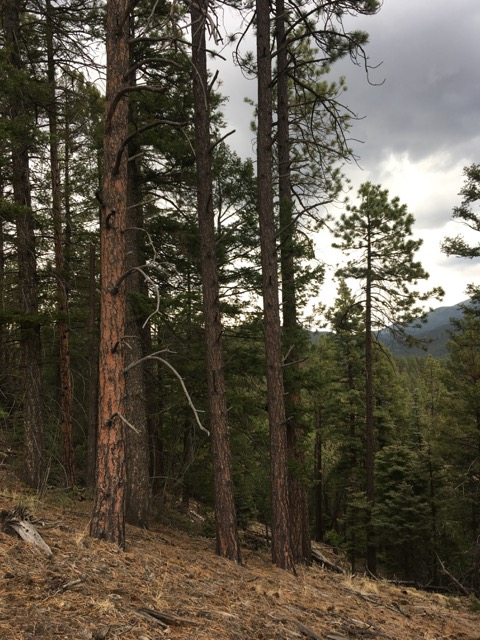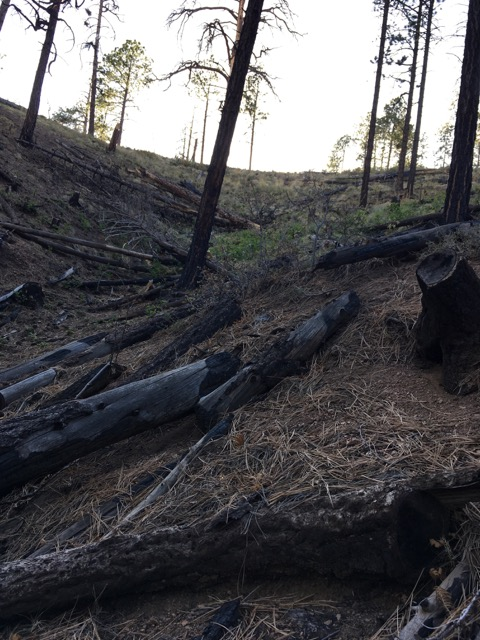Tree Cutting and Burning in Wilderness Quality Lands Near Hyde State Park Challenged
Thursday, May 24, 2018
Groups ask for Environmental Impact Statement and Wilderness protection
Contact: Sam Hitt, 505-577-2944, sam at wildwatershed.org
Additional Contacts:
Tom Woodbury, attorney, 650-238-8759, tom at wildlandsdefense.org
Dr. Ann McCampbell, 505-466-3622, drannmcc at aol.com
Jan Boyer, 505-982-4322, sfjanboyer at gmail.com


SANTA FE — Conservationists filed suit today in federal district court to halt drastic tree cutting and burning over nearly 2000 acres of potential wilderness in the national forest above Santa Fe New Mexico. Wild Watershed and two individuals are asking the Forest Service to take a hard look at the impacts of proposed slash and burn activities on native wildlife and roadless land.
The controversial Hyde Park Wildlands Urban Interface project is adjacent to Hyde State Park and the national scenic byway leading to the Santa Fe Ski Basin. Less than ten miles from Santa Fe's historic plaza, its rugged terrain is popular with local hikers and bird watchers.
First proposed in 2005, the Hyde Park Project was successfully appealed and stopped in 2006. During the Obama administration regulations protecting roadless national forest lands prevented tree cutting and burning. Hyde Park was proposed again only weeks after Trump was inaugurated.
"This administration is not only openly hostile to wilderness legislation, they want to destroy the possibility of roadless land ever becoming protected as wilderness. Hyde Park is being fast tracked while people are still in a state of shock over re-cent fires" said Sam Hitt founder of Wild Watershed. "In fact, logged over areas are far more likely to burn than the intact roadless land above Santa Fe. Trump appointees have a game plan-destroy the last of the best with the excuse that they are preventing fire and hope that no one is looking. Today we are asking a federal judge to take a hard look before our public lands are butchered again."
The Hyde Park project calls for leaving between 5 and 120 trees per acre with an average of 40 to 60 trees left per acre. A minimum of 90 and a maximum of 99 percent of existing forest cover would be removed. Ten percent of the cut area (80 acres) would be cleared of all trees. All 1875 acres would be either cut or burned, often both.
Plaintiffs ask that a comprehensive environmental impact statement be prepared for Hyde Park and the surrounding area to disclose and document treatment ef-fects. Hundreds of people signed a petition in 2005 making the same request.
On March 21, 2018 the Santa Fe national forest "categorically excluded" the Hyde Park project from detailed environmental review declaring there are no significant environmental impacts. The public was then prevented from objecting or appealing the decision.
The Hyde Park project is within the more than 30,000 acre proposed Black Canyon addition to the Pecos Wilderness. This area was described last year by a coalition of conservation groups as appearing "undisturbed and shaped by natural forces, with the scattered imprints of man substantially unnoticeable."
Intensive tree cutting and burning will destroy Hyde Park's wilderness character and make formal wilderness designation unlikely. Wilderness designation requires an act of Congress.
More than 90 percent of the Hyde Park project is inventoried roadless where timber harvest is generally banned under the 2001 Roadless Rule. Plaintiffs allege that the Santa Fe national forest inappropriately exploited a loophole in the rule that allows tree cutting "to reduce the risk of uncharacteristic wildfire effects."
The Hyde Park project is the first of many tree clearing and burning projects planned for 167 square miles of forest from the Santa Fe Ski basin to near Pecos. The National Environmental Policy Act requires that the combined impacts to wildlife habitat, water quality and scenic beauty be analyzed together instead of separately.
Historically forests in Hyde Park experienced both frequent low intensity fires and occasionally fires where most trees were killed. Aspens along the Ski Basin road are the result of large, hot fires in the 1890s. Large hot fires are ecologically im-portant and not uncharacteristic of the Hyde Park forests. According to a 2015 study of western forests including Hyde Park "the rate of recent high-severity fire in dry forests is within the range of historical rates."
The project is a boondoggle because it is unlikely to encounter the fire it was de-signed to withstand. The Forest Service acknowledges that fuels treatments (cut-ting and burning) are only effective for 10 to 15 years. The chance of a moderate to high intensity fire occurring in Hyde Park during that time is less than one percent. Since the impacts of repeat treatments was not considered, it is likely that any benefits of fire risk reduction are outweighed by the environmental cost.
The Santa Fe national forest failed to assess the effects of toxic smoke from pre-scribed fire on infants, mothers, the disabled, asthmatics and those with multiple chemical sensitives. Slow burning prescribed burns emit large amounts of fine particulate matter that lodge deep in the lungs. Smoke from prescribed fires con-tains mercury, a neurotoxic, and benzene, a carcinogen, as well as several other toxic air pollutants.
Plaintiffs have documented dozens of species of breeding birds in Hyde Park. Clear cutting stands of old growth aspen during the spring breeding season and removing thousands of conifer trees will kill nestlings, fledglings and eggs. Drastic reduction of tree cover violates Forest Service rules that protect the old growth habitat of the northern goshawk, a Forest Service sensitive species.
The population of Abert's squirrel is declining in northern New Mexico. Its habitat of interlocking ponderosa pine will be destroyed by massive clearing and burning. Abert's squirrel is key to maintaining ponderosa pine forests and is a major prey of the goshawk.
National forests provide an important reserve of carbon that is critical to maintain-ing the global balance of greenhouse gases. Prescribed burning in Hyde Park will produce significant amount of carbon dioxide and methane. The Santa Fe national forest argues that wildfire would result in greater emissions but fails to mention that prescribed burning will continue indefinitely and is planned for a much larger area in the future.
Plaintiffs will host a hike in Hyde Park for the interested public on Saturday June 2. See www.santafeforestcoalition.org for details.
See the full Complaint For Injunctive Relief.
 Previous
Previous